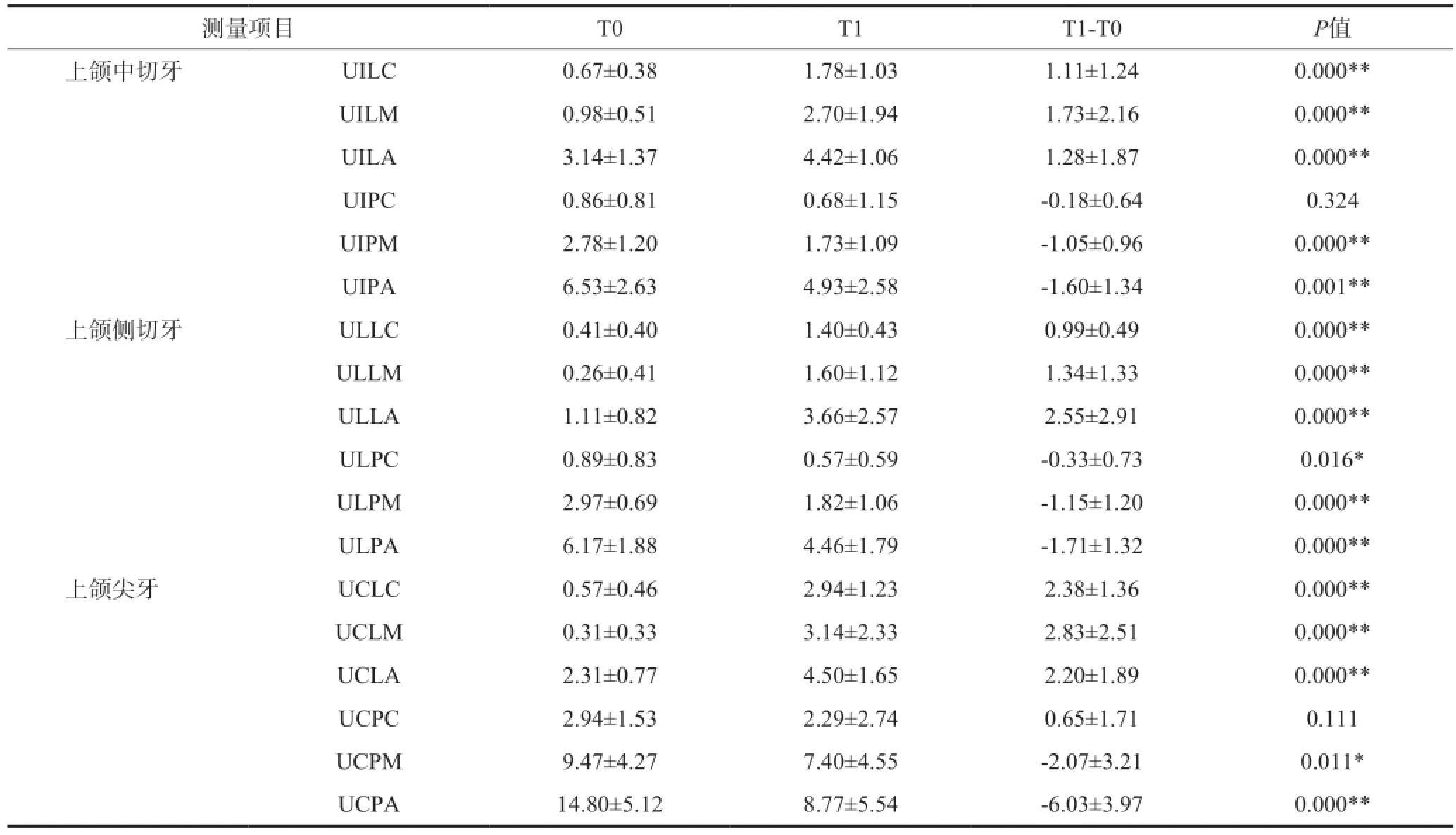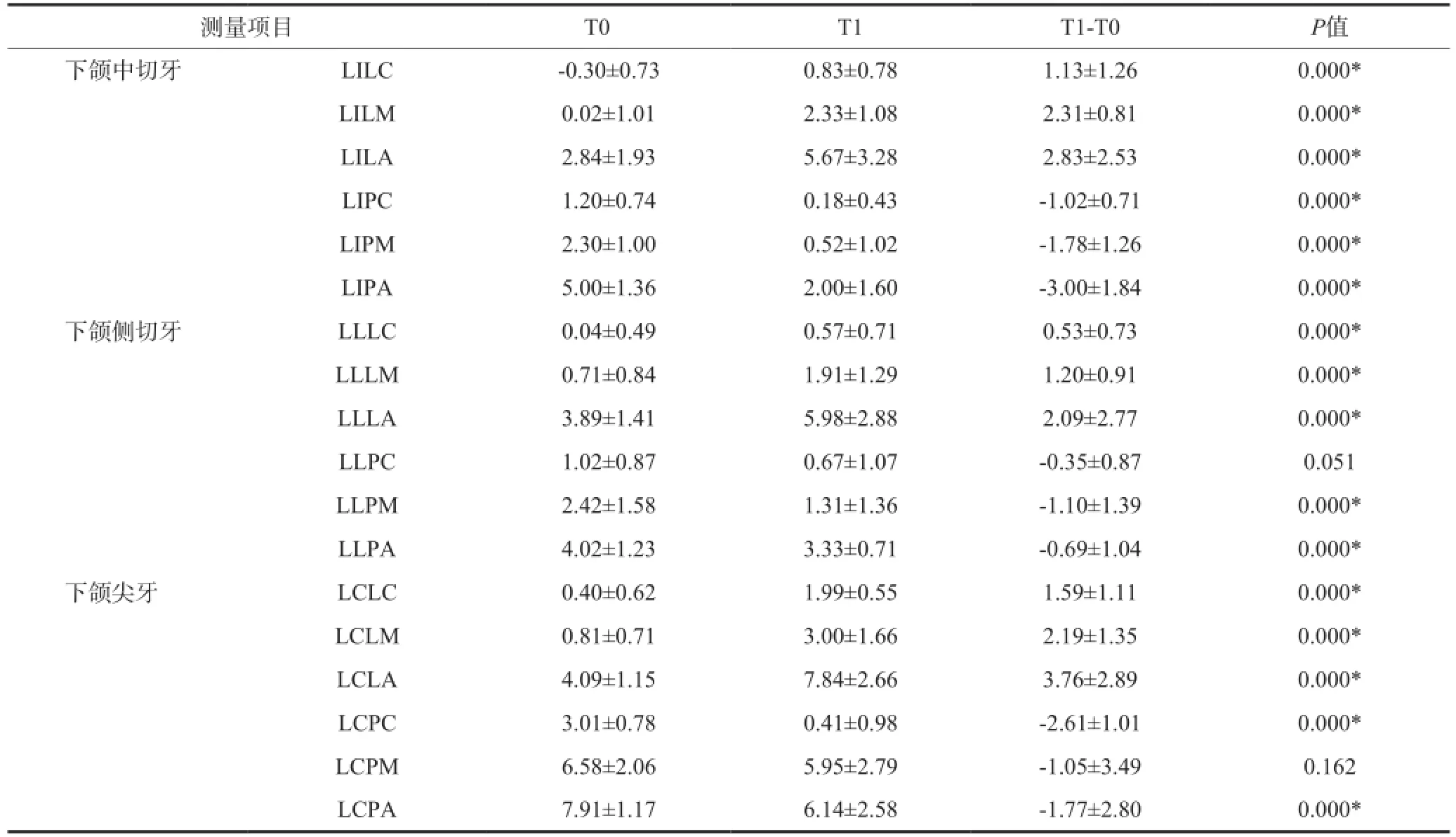青少年患者前牙内收过程中牙槽骨改建情况的锥形束CT研究
刘映鸿周泽渊赵奎唐曹敏王军
1.口腔疾病研究国家重点实验室 华西口腔医院(四川大学);2.正畸科,成都 610041
·锥形束CT专栏·
青少年患者前牙内收过程中牙槽骨改建情况的锥形束CT研究
刘映鸿1周泽渊1赵奎1唐曹敏1王军2
1.口腔疾病研究国家重点实验室 华西口腔医院(四川大学);2.正畸科,成都 610041
[摘要]目的 通过锥形束CT(CBCT)研究双颌前突的青少年患者前牙内收过程中前牙区牙槽骨改建情况及特点。方法 选取无正畸治疗史双颌前突并且拔除4颗第一前磨牙的青少年患者30例(男12例,女18例,年龄12~18岁),分别在内收前后1个月拍摄CBCT,测量上下颌每一颗前牙牙根颈1/3、中1/3、尖1/3处唇舌侧牙槽骨厚度,以及上中切牙切缘、牙根颈1/3、中1/3、尖1/3矢状向上内收前后移动的距离,利用SPSS 16.0软件对测量数据进行统计分析。结果青少年患者上下颌前牙区牙槽骨在前牙内收过程中总体表现为唇侧牙槽骨厚度增加,舌侧牙槽骨厚度减少。其中上颌中切牙根颈1/3及中1/3、上颌侧切牙根颈1/3及尖1/3、下颌中切牙根中1/3、下颌侧切牙根尖1/3、下颌尖牙根中1/3及尖1/3在内收后其牙槽骨厚度表现为增加;上颌尖牙尖1/3、下颌尖牙颈1/3在内收后其牙槽骨厚度表现为减少;其余位点牙槽骨厚度表现为不变。结论 青少年患者前牙内收过程中,前牙发生受控制的倾斜移动,内收后,前牙区牙槽骨总体表现为唇侧牙槽骨厚度增加,舌侧牙槽骨厚度减少。前牙内收后多数位点表现为随牙齿移动牙槽骨厚度增加。
[关键词]双颌前突; 牙槽骨; 内收; 锥形束CT
1 材料和方法
1.1 研究对象
本研究选取2012年6月—2014年6月至四川大学华西口腔医院正畸科就诊的12~18岁青少年患者30例,其中男性患者12例,女性患者18例。纳入标准:1)无正畸治疗史;2)安氏Ⅰ类、骨性Ⅰ类错畸形;3)凸面型,双颌前突;4)牙列完整,无先天缺牙,无前牙形态异常,拥挤度小于3 mm;5)正畸治疗前6个月及正畸治疗过程中未服用非甾体抗炎药物;6)无全身及系统性疾病,无牙周疾患,无明显牙根吸收;7)侧位片显示处于生长发育期,颈椎发育处于颈椎成熟阶段(cervical vertebral maturation stage,CVMS)Ⅲ期。治疗标准:1)拔除4颗第一前磨牙;2)使用Damon Q自锁托槽(标准转矩),上颌内收前牙主弓丝采用0.48 mm×0.64 mm不锈钢5 mm摇椅弓,下颌关闭间隙主弓丝采用0.46 mm× 0.64 mm不锈钢5 mm摇椅弓;3)使用最大支抗滑动法内收。排除标准:1)关闭间隙前单侧剩余间隙小于5 mm者;2)治疗前后资料不完整者。
1.2.1 拍摄时机 T0期(内收前):牙齿完全排齐,Spee曲线小于2 mm,覆、覆盖正常或浅覆、浅覆盖,上下颌均已更换至关闭间隙主弓丝且弓丝置入时间≥1个月。T1期(内收后):间隙完全关闭后1月。
1.2.2 拍摄条件 均采用四川大学华西口腔医院影像科3DX multi-image micro CT,设备在同一扫描参数(80 kV,3.5 mA,17.5 s,100 mm×140 mm)下对患者颌面部进行扫描。扫描时患者保持不动,取端坐位,保持身体直立,双眼平视前方,使用头颅固定装置及光标定位系统确保眶耳平面与地面平行,扫描平面与眶耳平面平行,面中线与设备中线重合,拍摄过程中保持牙尖交错位。
1.2.3 图像处理 CBCT图像资料保存为DICOM格式导入Dolphin imaging 11.0(Dolphin Imaging公司,美国)软件后进行三维重建并进行测量(图1)。

图 1 CBCT三维重建图Fig 1 Three-dimensional picture of CBCT
1.3 测量方法
1.3.1 上切牙内收量 矢状面上寻找上颌硬腭的最前点和最后点,分别定为ANS、PNS,连接ANS与PNS并过PNS做ANS-PNS的垂线,分别过上颌中切牙的切缘(A)、牙根颈1/3(B)、牙根中1/3(C)、牙根尖1/3(D)做ANS-PNS的平行线,与过PNS的ANS-PNS的垂线相交得到垂足H、G、F、E,分别测量垂足H、G、F、E到A、B、C、D的距离,得到A-H、B-G、C-F、D-E。以上线段内收前后长度的差值即是切牙内收量。
1.3.2 前牙唇舌侧牙槽骨厚度 通过前牙矢状截面,切缘与根尖点连接得到一条直线,定为牙长轴。釉牙骨质界与牙长轴LA相交的交点与根尖点之间的距离定为牙根长度。然后将牙根长度三等分定为颈1/3、中1/3、尖1/3,依据这3个点向唇、舌侧做3条垂直于牙长轴的垂线。分别测量牙槽窝内固有牙槽骨到唇、舌侧骨皮质的距离,作为唇、舌侧颈1/3、中1/3、尖1/3的牙槽骨厚度(表1)。

表 1 上、下颌测量项目简称Tab 1 Abbreviation of bimaxillary measurement
T0、T1期的CBCT数据均采用以上方法测量,其中左右侧同名牙分别测量后取平均值。测量均由同一位测量人员完成,并在第一次测完后2周再次测量后取平均值。
一女生率直地说我的口语不好,我感到震惊和感激。The pressure ends up to be driving force. I should treasure and carefully store it in my mind(2004年9月9日)
1.4 统计分析
采用SPSS 16.0统计软件对测量结果进行统计分析,当P<0.05时差异具有统计学意义。
2 结果
2.1 上颌中切牙内收量变化
青少年双颌前突患者上颌中切牙内收量变化见表2、图2。由表2可见,上颌中切牙内收过程中牙冠、牙根均向腭侧移动,牙冠内收量(5.32 mm± 2.26 mm)略大于根尖内收量(4.23 mm±2.16 mm),显示牙齿并没有明显的转矩丧失,整个内收过程中上颌前牙发生可控制的倾斜移动。整体内收量较大,上前牙过度唇倾的情况被有效改善。

表 2 青少年双颌前突患者上颌中切牙内收量变化Tab 2 Changes of maxillary central incisor in adolescent with bimaxillary protrusion mm, n=60

图 2 青少年双颌前突患者上颌中切牙内收量变化Fig 2 Changes of maxillary central incisor in adolescent with bimaxillary protrusion
2.2 内收前后上下颌牙槽骨厚度变化
上下颌前牙区牙槽骨在前牙内收过程总体基本上均表现为唇侧牙槽骨骨量增加,舌侧牙槽骨骨量减少(表3、4)。同时,下切牙根颈1/3及中1/3牙槽骨骨壁内收前较薄,甚至有骨开窗、骨开裂现象,但是在内收后均有好转(图3)。
2.3 内收前后唇舌侧牙槽骨厚度变化
青少年双颌前突患者内收前后唇舌侧牙槽骨厚度变化对比结果见表5。内收过程中上颌中切牙根颈1/3和中1/3、上颌侧切牙根颈1/3和尖1/3、下颌中切牙根中1/3、下颌侧切牙根尖1/3、下颌尖牙根中1/3及尖1/3唇侧牙槽骨的增加量大于舌侧牙槽骨的吸收量,差异有统计学意义(P<0.05),内收后其牙槽骨厚度总体表现为增加;上颌尖牙根颈1/3唇、舌侧牙槽骨均表现为增加,内收后牙槽骨厚度增加;上颌尖牙尖1/3、下颌尖牙颈1/3其舌侧吸收量大于唇侧增加量,差异有统计学意义(P<0.05),内收后其牙槽骨厚度总体表现为减少。

表 3 青少年患者内收前后上颌前牙区唇舌侧牙槽骨厚度测量值比较Tab 3 Comparison of the labial and palatal alveolar bone thickness in the maxillary anterior regions in adolescent before and after retraction mm, n=60

表 4 青少年患者内收前后下颌前牙区唇舌侧牙槽骨厚度测量值比较Tab 4 Comparison of the labial and palatal alveolar bone thickness in the mandibular anterior regions in adolescent before and after retraction mm, n=60
其余位点唇舌侧牙槽骨厚度的改变量之间差距较小,经t检验后,P均大于0.05,差异无统计学意义,可认为这些位点的唇侧牙槽骨增加量与舌侧吸收量大致相等,内收后其牙槽骨厚度总体表现为不变。综上,前牙内收后前牙区多数位点表现为随着牙齿移动牙槽骨的厚度增加。

图 3 青少年双颌前突患者下颌中切牙内收量变化Fig 3 Changes of mandibular central incisor in adolescent with bimaxillary protrusion

表 5 青少年患者内收前后牙槽骨厚度变化量对比Tab 5 Comparison of alveolar bone thickness changes in adolescent before and after retraction mm, n=60
3 讨论
3.1 切牙移动的解剖界限
近年来,有学者研究了前牙在牙槽骨中的位置,蔡留意等[5]研究了安氏Ⅰ类成人前牙区牙槽宽度及根尖位置的特征,发现上切牙根尖处牙槽宽度显著大于下切牙根尖处牙槽宽度,因此上切牙根尖可移动范围较下切牙大。姜若萍等[6]报道中国人正常人群的上切牙根尖点位于基骨中间偏唇侧,下切牙根尖点则位于基骨中间偏舌侧。牙齿在移动过程中,若上下牙槽骨宽度不足、切牙过度内收或唇倾将导致牙根与皮质骨的接触,造成牙齿移动受阻,甚至出现牙根吸收、骨开窗及骨开裂等现象。因此,明确牙根位于牙槽骨中的位置及上下颌前牙区牙槽骨的宽度对于预测上下颌前牙内收的量及方向具有重要意义。
另有学者研究发现,未治疗患者牙槽骨也存在骨丧失的现象。2010年,Evangelista等[7]研究发现,安氏Ⅰ类患者骨开裂的发生率高于安氏Ⅱ类1分类的患者,提示骨开裂是正畸治疗前需要关注的一个问题,特别是在安氏Ⅰ类患者中。Nahm等[8]报道安氏Ⅰ类双颌前突患者,上颌切牙区唇侧骨丧失率为19.27%,下颌唇侧骨丧失率为26.98%,由此可见,下颌前牙区牙槽骨骨丧失率大于上颌,并且下颌舌侧骨丧失率高于唇侧,结果高达31.25%。显然,下颌前牙区骨支持组织较为薄弱,治疗前骨丧失率已经较高,在正畸治疗中要根据骨量制定合理的矫治方案。
3.2 切牙内收过程中牙槽骨厚度变化
经典的正畸牙齿移动理论是“牙槽骨跟随牙齿移动”,受压侧牙槽骨吸收,牵张侧牙槽骨增生,这样牙槽骨将以完全改建的方式跟随牙齿移动。但是许多研究结果显示,在正畸牙齿移动过程中,牙槽骨改建的速度实际上往往要滞后于牙齿移动的速度[9-10]。
本研究发现,前牙在多数位点上其牙槽骨并不完全保持原有的厚度跟随牙齿移动。内收过程中,上颌中切牙根颈1/3及中1/3、上颌侧切牙根颈1/3及尖1/3、上颌尖牙颈1/3、下颌中切牙根中1/3、下颌侧切牙根尖1/3、下颌尖牙根中1/3及尖1/3唇侧牙槽骨厚度增加,上颌尖牙尖1/3、下颌尖牙颈1/3牙槽骨厚度减少。并且该实验观察到上颌尖牙腭侧根颈1/3处的牙槽骨厚度增加,其余牙位牙槽骨厚度均减少。Cobo等[11]认为在前牙内收过程中压力集中于舌侧牙槽嵴顶处,此处牙槽骨改建无法满足大范围的牙齿移动,导致骨量减少,其结果与本研究不一致,可能是由于其纳入的研究对象为成人,而本研究该部分纳入的研究对象是青少年,具有更活跃的牙槽骨代谢。内收后,前牙区牙槽骨总体表现为唇侧牙槽骨厚度增加,舌侧牙槽骨厚度减少。这与刘妍等[12]的研究结果相似,其选取拔除下颌第一前磨牙治疗的青少年患者43例,测量下颌切牙唇舌侧牙槽骨宽度的变化及牙齿的移动量,发现正畸治疗阶段,下切牙唇侧牙槽骨改建速度舌侧牙槽骨厚度明显减少,但在保持期阶段舌侧牙槽骨会继续沉积。Mulie等[13]认为,牙齿移动后,骨皮质会在6个月之后才发生重建。但Engelking等[14]研究发现,正畸治疗后舌侧牙槽嵴顶处牙槽骨厚度减小,几年后并未出现修复和重建。可见对于舌侧牙槽嵴顶处牙槽骨的改建问题目前尚无统一的结论,尚需后期随访继续观察牙槽骨改建情况。
3.3 二维及三维牙槽骨测量方法
在临床工作中,正畸医生最常采用头颅侧位片来评价颅颌面部及牙槽骨的形态结构。但其摄取的图像全被压缩在一个平面内,属于二维成像。头颅侧位片在重叠过程中图像会放大变形,甚至可导致前牙颏部联合处变窄、失真[15]。并且头颅侧位片在矢状向上的重叠呈现的图像均有解剖结构的重影,在观测牙槽骨情况特别是前牙区牙槽骨时有一定的局限性[16]。另有学者[17]发现,二维影像不能完全显示出骨开窗和骨开裂等牙槽骨组织病理学改变。
CBCT采用三维影像学手段,能对局部骨组织进行垂直以及横断扫描,且可从任意不同角度对牙齿进行扫描,对牙周膜及骨小梁等细微结构显示清晰[18]。并且因辐射剂量小、空间分辨率高及价格适中等优点,成为颅颌面三维影像检测的常用手段。CBCT因其独特的优势,逐渐被口腔医生首选为评估牙槽骨形态和骨密度的工具,具有良好的准确性及可重复性。国内外学者[19-22]评价了CBCT对所拍摄的牙槽骨的形态、高度以及厚度的准确性,发现CBCT能精确测量牙槽骨的高度和厚度,评价牙周的骨支持状态,可将其作为组织学线性测量的首选工具。
本研究正是利用了CBCT的三维特点,定点测量内收前后唇、舌侧牙槽骨厚度的变化,扫描厚度为1 mm,可清楚判断牙齿及牙槽骨的界限。且CBCT是以1︰1的比例显示牙齿、牙槽骨和相关组织,故可直接对牙槽骨及牙齿相关参数进行精确地测量,结果准确性及可靠性较高。
综上所述,青少年患者前牙内收过程中,前牙发生受控制的倾斜移动,内收后,前牙区牙槽骨总体表现为唇侧牙槽骨厚度增加,舌侧牙槽骨厚度减少。前牙内收后多数位点表现为随牙齿移动牙槽骨厚度增加。
[参考文献]
[1]冯云霞, 米宇菁, 刘立青. 正畸治疗中拔牙矫治的临床分析[J]. 现代口腔医学杂志, 2002, 16(6):530-531. Feng YX, Mi YJ, Liu LQ. The analysis of extraction in orthodontic treatment[J]. J Modern Stomatol, 2002, 16(6):530-531.
[2]宋卫华, 刘红英, 李东, 等. 青少年双颌前突患者拔牙矫治前后侧面部软组织改变的研究[J]. 口腔医学, 2010, 30 (9):535-537. Song WH, Liu HY, Li D, et al. Study of changes in soft tissue of facial profile after orthodontic treatment with four premolars extracted in bimaxillary protrusionin adolescents[J]. Stomatology, 2010, 30(9):535-537.
[3]Yagci A, Veli I, Uysal T, et al. Dehiscence and fenestration in skeletal ClassⅠ, Ⅱ, and Ⅲ malocclusions assessed with cone-beam computed tomography[J]. Angle Orthod, 2012,82(1):67-74.
[4]Ludlow JB, Ivanovic M. Comparative dosimetry of dental CBCT devices and 64-slice CT for oral and maxillofacial radiology[J]. Oral Surg Oral Med Oral Pathol Oral Radiol Endod, 2008, 106(1):106-114.
[5]蔡留意, 丁寅. 安氏Ⅰ类错年轻成人前牙区牙槽宽度及根尖位置的特征[J]. 口腔医学研究, 2012, 28(12):1269-1271. Cai LY, Ding Y. Characteristics of anterior root apex position and alveolar width of the young adults with angle class Ⅰmalocclusion[J]. J Oral Sci Res, 2012, 28(12):1269-1271.
[7]Evangelista K, Vasconcelos Kde F, Bumann A, et al. Dehiscence and fenestration in patients with ClassⅠand Class Ⅱ Division 1 malocclusion assessed with cone-beam computed tomography[J]. Am J Orthod Dentofacial Orthop, 2010,138(2):133.e1-133.e7; discussion 133-135.
[8]Nahm KY, Kang JH, Moon SC, et al. Alveolar bone loss around incisors in ClassⅠbidentoalveolar protrusion patients: a retrospective three-dimensional cone beam CT study[J]. Dentomaxillofac Radiol, 2012, 41(6):481-488.
[9]Vardimon AD, Oren E, Ben-Bassat Y. Cortical bone remodeling/tooth movement ratio during maxillary incisor retraction with tip versus torque movements[J]. Am J Orthod Dentofacial Orthop, 1998, 114(5):520-529.
[10]Ahn HW, Moon SC, Baek SH. Morphometric evaluation of changes in the alveolar bone and roots of the maxillary anterior teeth before and after en masse retraction using cone-beam computed tomography[J]. Angle Orthod, 2013,83(2):212-221.
[11]Cobo J, Argüelles J, Puente M, et al. Dentoalveolar stress from bodily tooth movement at different levels of bone loss [J]. Am J Orthod Dentofacial Orthop, 1996, 110(3):256-262.
[12]刘妍, 江久汇, 张海萍, 等. 正畸治疗后下颌前牙区牙槽骨改建状况的长期追踪研究[J]. 实用口腔医学杂志, 2008,23(6):831-835. Liu Y, Jiang JH, Zhang HP, et al. Long-term remodeling of anterior alveolar bone from treatment to retention[J]. J Pract Stomatol, 2008, 23(6):831-835.
[13]Mulie RM, Hoeve AT. The limitations of tooth movement within the symphysis, studied with laminagraphy and standardized occlusal films[J]. J Clin Orthod, 1976, 10(12):882-893, 886-889.
[14]Engelking G, Zachrisson BU. Effects of incisor repositioning on monkey periodontium after expansion through the cortical plate[J]. Am J Orthod, 1982, 82(1):23-32.
[15]Nayak Krishna US, Shetty A, Girija MP, et al. Changes in alveolar bone thickness due to retraction of anterior teeth during orthodontic treatment: a cephalometric and computed tomography comparative study[J]. Indian J Dent Res, 2013,24(6):736-741.
[16]李瑶琴, 李琥, 陈文静. 正畸治疗中牙槽骨变化的研究进展[J]. 口腔生物医学, 2014, 5(1):38-41. Li YQ, Li H, Chen WJ. Research progress of alveolar bone changes in orthodontic treatment[J]. Oral Biomedicine, 2014,5(1):38-41.
[17]Wehrbein H, Bauer W, Diedrich P. Mandibular incisors,alveolar bone, and symphysis after orthodontic treatment. A retrospective study[J]. Am J Orthod Dentofacial Orthop,1996, 110(3):239-246.
[18]Nair R, Deguchi TS, Li X, et al. Quantitative analysis of the maxilla and the mandible in hyper- and hypodivergent skeletal Class Ⅱ pattern[J]. Orthod Craniofac Res, 2009,12(1):9-13.
[19]Veyre-Goulet S, Fortin T, Thierry A. Accuracy of linear measurement provided by cone beam computed tomography to assess bone quantity in the posterior maxilla: a human cadaver study[J]. Clin Implant Dent Relat Res, 2008, 10(4): 226-230.
[20]Lagravère MO, Carey J, Toogood RW, et al. Three-dimensional accuracy of measurements made with software on cone-beam computed tomography images[J]. Am J Orthod Dentofacial Orthop, 2008, 134(1):112-116.
[21]Patcas R, Müller L, Ullrich O, et al. Accuracy of cone-beam computed tomography at different resolutions assessed on the bony covering of the mandibular anterior teeth[J]. Am J Orthod Dentofacial Orthop, 2012, 141(1):41-50.
[22]Timock AM, Cook V, McDonald T, et al. Accuracy and reliability of buccal bone height and thickness measurements from cone-beam computed tomography imaging[J]. Am J Orthod Dentofacial Orthop, 2011, 140(5):734-744.
(本文编辑 杜冰)
[中图分类号]R 445
[文献标志码]A [doi] 10.7518/hxkq.2016.01.016
[收稿日期]2015-05-17; [修回日期] 2015-11-05
[基金项目]国家自然科学基金(0040305401249)
[作者简介]刘映鸿,学士,E-mail:luilui21@qq.com
[通信作者]王军,教授,博士,E-mail:wangjunv@163.com
Morphometric evaluation of changes in the alveolar bone of adolescents with bimaxillary protrusion via cone beamcomputed tomography
Liu Yingho g1, Zhou Ze yuan1, Zhao Kui1, Tang Caomin1, Wang Jun2.
(1. State Key Laboratory of Oral Diseases, West China Hospital of Stomatology, Sichuan University, Chengdu 610041, China; 2. State Key Laboratory of Oral Diseases, Dept. of Orthodontics, West China Hospital of Stomatology, Sichuan University, Chengdu 610041, China)
Supported by: The National Natural Science Foundation of China (0040305401249). Correspondence: Wang Jun, E-mail: wangjunv@163.com.
[Abstract]Objective This study aimed to evaluate the morphometric changes in the alveolar bone of the maxillary and mandibular anterior regions after retraction in adolescents. Methods The sample size comprised 30 adolescent patients with class 1 bimaxillary protrusion (12 males and 18 females, age: 12-18 years old) and were treated by extracting four first premolars. Cone beam computed tomography (CBCT) was performed 1 month before and 1 month after the retraction. For each maxillary and mandibular anterior tooth, the labial and palatal alveolar plates at cervical 1/3, middle 1/3, and apical 1/3 levels for bone thickness changes during the retraction of the maxillary and mandibular anterior regions were checked. The movements of cervical 1/3, middle 1/3, and apical 1/3 levels of the maxillary central incisor were measured. Statistical analyses were performed with SPSS 16.0. Results For the adolescents, alveolar bone thickness increased on the labial side and decreased on the palatal side. The alveolar bone thicknesses of cervical 1/3 and middle 1/3 of maxillary central incisor, cervical 1/3 and apical 1/3 of maxillary lateral incisor, middle 1/3 of mandibular central incisor, apical 1/3 of mandibular lateral incisor, and middle 1/3 and apical 1/3 of mandibular canine all increased after retraction. By contrast, the alveolar bone thickness of the apical 1/3 of maxillary canine and the cervical 1/3 of mandibular canine decreased after retraction. No statistically significant difference was observed in other region. Conclusion During retraction, a controlled tipping movement occur in adolescents. After retraction, the alveolar bone thickness of the labial side increase, whereas that of the palatal side decrease. Moreover,the thicknesses of major areas in the alveolar bone significantly increase.
[Key words]bimaxillary protrusion; alveolar bone; retraction; cone beam computed tomography

